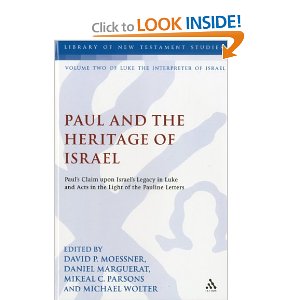The essay written by Christopher Mount, entitled “Paul’s Place in Early Christianity” seems to be encumbered from the outset by a series of assumptions and arguments from silence that are probably wrong. The first of these is the assumption (see p. 93 n. 10) that Matthew, Mark, and John did not feel the necessity of linking the life of Jesus with the subsequent story and history of the church. First of all, we do not know what they ‘felt’ about this matter. If we were to judge it from the internal evidence of these Gospels themselves we would have to assume that this is completely false. Each of these Gospels relates itself to the Sitz im Lebens of the churches to which they are addressed and they reflect the ongoing life of the church and its history in so doing. Nowhere is this more apparent than in the Gospel of John, especially in the appendix in John 21 where comment is made about the community, and how they related to the traditions originating with the Beloved Disciple. But secondly, there is the further problematic assumption that Luke-Acts (and perhaps especially Acts) are probably second century documents. This argument absolutely makes no sense in light of the Lukan prologue which tells us that the author consulted eyewitnesses and the original preachers of the Word, something he certainly could not have done in the second century A.D. It also makes little sense in light of the evidence that there are fragments of Acts from the second century A.D. (one at Macquarrie of Acts 8).
What is interesting and helpful about this essay is that it focuses on and shows how Irenaeus tries to combine and blend the Lukan material about Paul with that from Paul’s letters, while rejecting later apocryphal material about Paul from various sources. Camp however sees in Irenaeus an attempt to rewrite history, and even create a canon and a history in Book 3 of his Vs. Heresies which did not previously exist. This conclusion may also be doubted in light of the Muratorian Canon list which likely comes from the second century A.D. Not surprisingly Camp simply dismisses with the wave of a hand the we passages in Acts with “The author does not claim to be the narrator of the second part of Acts nor a companion of Paul” (p. 95). Actually, that is precisely what he does in the latter part of Acts, since he is the author of both Luke and Acts, reflect the same style, grammar, syntax, and historical and theological agendas in both volume, and since Acts 1 makes clear that the second volume is a continuation of the first one! Camp is right however that Acts does not place Peter in Rome, nor do Paul’s letters (but see 1 Pet. 5). This tradition of Peter and Paul in Rome, especially as a backdrop to the later importance of Clement of Rome and the church in Rome comes from elsewhere. This does not however make it later, or wrong. It also doesn’t make it Irenaeus’ invention. It is certainly true however, that Irenaeus, the heresiarch is all about asserting that Paul belongs in the company of the Gospel writers, including Luke, and that it is not right to separate Paul from any of the Gospel writers (vs. Marcion) nor is it right to reject Paul and his writings in favor of one or more Gospels (vs. the Gnostics). In short, Irenaeus is helping to define canonical and theological orthodoxy for his own day.
It is a pity that Camp does not, or was not able to take account of Richard Bauckham’s important work on Papias (Jesus and the Eyewitnesses) because had he done so, it would have saved him from various kinds of misconstruals of Papias. Camp is however right that since we have to read Papias through the filter of Eusebius, it is important to know Eusebius’ own tendencies and take account of them in assessing what he says about Papias. For example, Eusebius does not care for Papias’ millenial fervor. (pp. 98-99).
Mount goes on to accuse yours truly, Steve Walton, and David Wenham of reading the history of early Christianity in the light of Irenaeus’ reconstruction of said history. The problem with this accusation is its assumption that Irenaeus just has to be wrong about early Christian history. But the even further problem with it is that Irenaeus is not the first person to come up with the notion of orthodoxy or an orthodox Christian tradition by which other traditions are found wanting. Indeed, we find this already in various places in the NT itself. False prophets and false teachers come in for heavy weather at various junctures in the NT itself, and rightly so. There was indeed a normative apostolic tradition when it came to things like Christology and pneumatology. These things were not invented or distorted by Irenaeus or others in the late second century or thereafter. Indeed, Papias at the beginning of the second century already bears witness to this.
Mount finally describes the problem which is most agitating him, even when it comes to Vielhauer— the “persistent fiction about Paul’s place in early Christianity. Vielhauer’s Paul, earliest Christianity, and nascent early catholic church are historical fictions created around the Paul of the New Testament. The Paul of the New Testament emerged in the second century when Paul became a character in competing constructions of the history of Christianity.” (p. 114).
And since, in Mount’s view, history is apparently written by the winners, Irenaeus’ false and misleading representation of Christianity is the pernicious source of all this misinterpreting of Paul, Acts, and early Christianity by liberals and conservatives alike. Of course these objections are shown to be insubstantial in the extreme if in fact Acts was written by a sometime companion of Paul who knew the man, and the estimation of when a collection of Paul’s letters became important as represented in 2 Pet. 3 is taken seriously, namely well before the time of Irenaeus.













